Red-Light (670 nm) Therapy Reduces Mechanical Sensitivity and Neuronal Cell Death, and Alters Glial Responses after Spinal Cord Injury in Rats
- PMID: 32552352
- PMCID: PMC7585617
- DOI: 10.1089/neu.2020.7066
Red-Light (670 nm) Therapy Reduces Mechanical Sensitivity and Neuronal Cell Death, and Alters Glial Responses after Spinal Cord Injury in Rats
Abstract
Individuals with spinal cord injury (SCI) often develop debilitating neuropathic pain, which may be driven by neuronal damage and neuroinflammation. We have previously demonstrated that treatment using 670 nm (red) light irradiation alters microglia/macrophage responses and alleviates mechanical hypersensitivity at 7 days post-injury (dpi). Here, we investigated the effect of red light on the development of mechanical hypersensitivity, neuronal markers, and glial response in the subacute stage (days 1-7) following SCI. Wistar rats were subjected to a mild hemi-contusion SCI at vertebra T10 or to sham surgery followed by daily red-light treatment (30 min/day; 670 nm LED; 35 mW/cm2) or sham treatment. Mechanical sensitivity of the rat dorsum was assessed from 1 dpi and repeated every second day. Spinal cords were collected at 1, 3, 5, and 7 dpi for analysis of myelination, neurofilament protein NF200 expression, neuronal cell death, reactive astrocytes (glial fibrillary acidic protein [GFAP]+ cells), interleukin 1 β (IL-1β) expression, and inducible nitric oxide synthase (iNOS) production in IBA1+ microglia/macrophages. Red-light treatment significantly reduced the cumulative mechanical sensitivity and the hypersensitivity incidence following SCI. This effect was accompanied by significantly reduced neuronal cell death, reduced astrocyte activation, and reduced iNOS expression in IBA1+ cells at the level of the injury. However, myelin and NF200 immunoreactivity and IL-1β expression in GFAP+ and IBA1+ cells were not altered by red-light treatment. Thus, red-light therapy may represent a useful non-pharmacological approach for treating pain during the subacute period after SCI by decreasing neuronal loss and modulating the inflammatory glial response.
Keywords: neuroinflammation; neuronal death; neuropathic pain; photobiomodulation; spinal cord injury.
Conflict of interest statement
No competing financial interests exist.
Figures

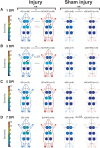

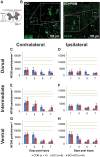
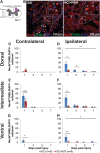
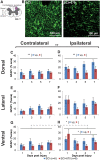
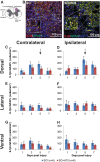
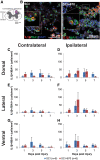
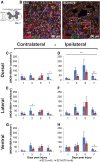
Similar articles
-
Red LED photobiomodulation reduces pain hypersensitivity and improves sensorimotor function following mild T10 hemicontusion spinal cord injury.J Neuroinflammation. 2016 Aug 26;13(1):200. doi: 10.1186/s12974-016-0679-3. J Neuroinflammation. 2016. PMID: 27561854 Free PMC article.
-
Astrocytic Inducible Nitric Oxide Synthase Upregulation Contributes to Chronic Below-Level Neuropathic Pain Following Spinal Cord Injury in Male Rats.Eur J Pain. 2025 Jul;29(6):e70047. doi: 10.1002/ejp.70047. Eur J Pain. 2025. PMID: 40411263 Free PMC article.
-
Administration of anti-GFAP antibodies increases CGRP expression and increases pain hypersensitivity in spinal cord injured animals.Int J Immunopathol Pharmacol. 2025 Jan-Dec;39:3946320251320754. doi: 10.1177/03946320251320754. Int J Immunopathol Pharmacol. 2025. PMID: 40019103 Free PMC article.
-
Neuronal-Glial Interactions Maintain Chronic Neuropathic Pain after Spinal Cord Injury.Neural Plast. 2017;2017:2480689. doi: 10.1155/2017/2480689. Epub 2017 Aug 29. Neural Plast. 2017. PMID: 28951789 Free PMC article. Review.
-
Mechanisms and Therapeutic Prospects of Microglia-Astrocyte Interactions in Neuropathic Pain Following Spinal Cord Injury.Mol Neurobiol. 2025 Apr;62(4):4654-4676. doi: 10.1007/s12035-024-04562-1. Epub 2024 Oct 29. Mol Neurobiol. 2025. PMID: 39470872 Review.
Cited by
-
The involvement and significance of M2 macrophages in neuropathic pain following spinal cord injury: a systematic review.J Physiol Sci. 2024 Sep 18;74(1):45. doi: 10.1186/s12576-024-00932-5. J Physiol Sci. 2024. PMID: 39294621 Free PMC article.
-
Photobiomodulation reduces neuropathic pain after spinal cord injury by downregulating CXCL10 expression.CNS Neurosci Ther. 2023 Dec;29(12):3995-4017. doi: 10.1111/cns.14325. Epub 2023 Jul 20. CNS Neurosci Ther. 2023. PMID: 37475184 Free PMC article.
-
Photobiomodulation inhibits the activation of neurotoxic microglia and astrocytes by inhibiting Lcn2/JAK2-STAT3 crosstalk after spinal cord injury in male rats.J Neuroinflammation. 2021 Nov 5;18(1):256. doi: 10.1186/s12974-021-02312-x. J Neuroinflammation. 2021. PMID: 34740378 Free PMC article.
-
Differences in the Effectiveness of Different Physical Therapy Modalities in the Treatment of Delayed-Onset Muscle Soreness: A Systematic Review and Bayesian Network Meta-Analysis.J Pain Res. 2025 Jun 15;18:2993-3008. doi: 10.2147/JPR.S519242. eCollection 2025. J Pain Res. 2025. PMID: 40538474 Free PMC article. Review.
References
-
- World Health Organization and International Spinal Cord Society. (2013). International perspectives on spinal cord injury. World Health Organization: Geneva, Switzerland.. https://apps.who.int/iris/bitstream/handle/10665/94190/9789241564663_eng...
-
- Turner J.A., Cardenas D.D., Warms C.A., and McClellan C.B. (2001). Chronic pain associated with spinal cord injuries: a community survey. Arch. Phys. Med. Rehabil. 82, 501–509 - PubMed
-
- Pascoal-Faria P., Yalcin N., and Fregni F. (2015). Neural markers of neuropathic pain associated with maladaptive plasticity in spinal cord injury. Pain Pract. 15, 371–377 - PubMed
-
- Finnerup N.B., Norrbrink C., Trok K., Piehl F., Johannesen I.L., Sorensen J.C., Jensen T.S., and Werhagen L. (2014). Phenotypes and predictors of pain following traumatic spinal cord injury: a prospective study. J. Pain 15, 40–48 - PubMed
Publication types
MeSH terms
LinkOut - more resources
Full Text Sources
Medical
Research Materials
Miscellaneous

